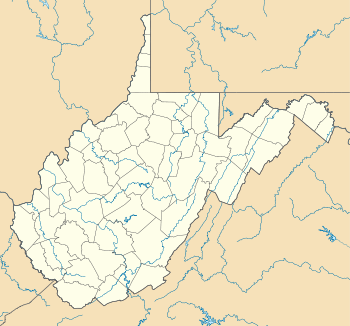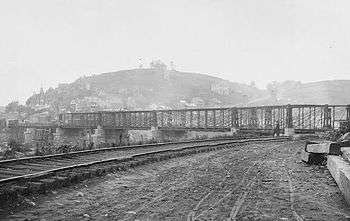B & O Railroad Potomac River Crossing
|
B & O Railroad Potomac River Crossing | |
|
Aerial view looking west. Left to right: Stone piers from 1851 Bollman bridge; 1894 bridge; 1931 bridge. | |
  | |
| Location | Harper's Ferry, West Virginia |
|---|---|
| Coordinates | 39°19′27″N 77°43′43″W / 39.32417°N 77.72861°WCoordinates: 39°19′27″N 77°43′43″W / 39.32417°N 77.72861°W |
| Built | 1851 |
| Architect | Wendel Bollman et al. |
| Architectural style | Other |
| Demolished | 1936 (flood) |
| NRHP Reference # | 78001484 |
| Added to NRHP | February 14, 1978[1] |
The Baltimore and Ohio Railroad Crossings at the Potomac River are a set of railroad bridges that span the Potomac River between Maryland Heights, Maryland and Harpers Ferry, West Virginia in the United States.
History
The original Harper's Ferry operated from 1747 until it was replaced by a timber covered road bridge in about 1824 at the confluence of the Potomac and Shenandoah Rivers.[2][3]
In 1839, the B&O's first crossing over the Potomac was an 830 feet (250 m) covered wood truss. The single-track bridge, which comprised six river spans plus a span over the Chesapeake and Ohio Canal, was designed by Benjamin Henry Latrobe, II.[4]:34 Latrobe designed a "Y" span for the route to Winchester, which was added to the bridge in 1839.[4]:65 The bridge was destroyed during the American Civil War and was subsequently replaced by temporary structures.[4]:65
In 1851, a second bridge was built across the Shenandoah becoming was one of the earliest Bollman trusses in existence.[4]:67 A newer Bollman truss bridge, which carried both rail and highway traffic, opened in 1870. It was washed away in a flood in 1936.
The two crossing today, which are on different alignments, are from the late 19th century and early 20th century. A steel Pratt truss and plate girder bridge was built in 1894 to carry the B&O Valley line (now the CSX Shenandoah Subdivision) toward Winchester, Virginia along the Shenandoah River. This was complimented in 1930-31 with a deck plate girder bridge that carries the Baltimore and Ohio Railroad (B&O) main line to Martinsburg, West Virginia (the line is now the CSX Cumberland Subdivision).
A rail tunnel was built at the same time as the 1894 bridge to carry the line through the Maryland Heights bypassing a sharp curve. In the 1930s the western end of the tunnel was widened in during the construction of the second bridge to allow the broadest possible curve across the river.
See also
- Harpers Ferry National Historical Park
- Harpers Ferry Historic District
- List of bridges documented by the Historic American Engineering Record in Maryland
- List of bridges documented by the Historic American Engineering Record in West Virginia
- List of bridges on the National Register of Historic Places in Maryland
References
- ↑ National Park Service (2008-04-15). "National Register Information System". National Register of Historic Places. National Park Service.
- ↑ Note: Harwood (p. 44) states an opening date of 1829.
- ↑ Paula Stoner Dickey and Robert M. Vogel (June 26, 1973). "National Register of Historic Places Nomination: B & O Railroad Potomac River Crossing" (pdf). National Park Service.
- 1 2 3 4 Harwood, Herbert H., Jr. (1994). Impossible Challenge II: Baltimore to Washington and Harpers Ferry from 1828 to 1994. Baltimore, MD: Barnard, Roberts & Co. ISBN 0934118221.
External links
- Historic American Engineering Record (HAER) No. MD-16, "Baltimore & Ohio Railroad, Harpers Ferry Bridge Piers, Junction of Potomac & Shenandoah Rivers, Sharpsburg, Washington County, MD", 5 photos, 1 photo caption page
- HAER No. WV-36, "Baltimore & Ohio Railroad, Bollman Bridge, Spanning Potomac River at Harpers Ferry, Harpers Ferry, Jefferson County, WV", 6 measured drawings
- B & O Railroad Potomac River Crossing, Washington County, including photo in 1978, at Maryland Historical Trust


